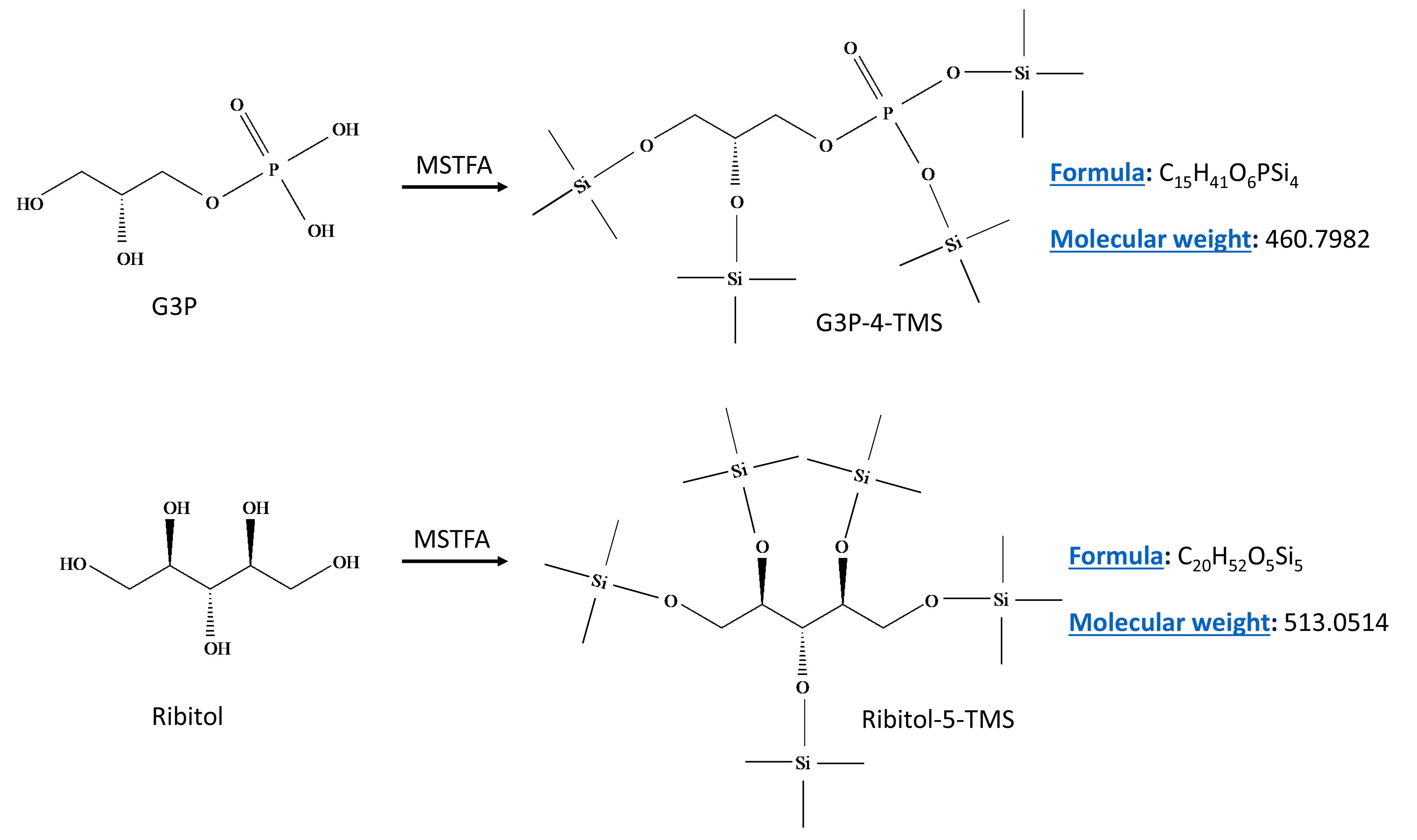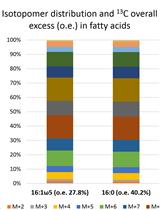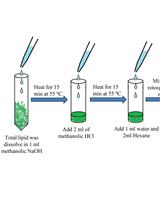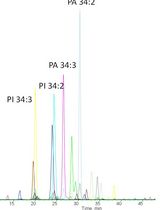- EN - English
- CN - 中文
Rapid and Reliable Quantification of Glycerol-3-phosphate Using Gas Chromatography–coupled Mass Spectrometry
气相色谱-质谱联用法以快速可靠地定量甘油-3-磷酸
发布: 2023年04月05日第13卷第7期 DOI: 10.21769/BioProtoc.4645 浏览次数: 1652
评审: Saptashati BiswasAnonymous reviewer(s)
Abstract
Glycerol-3-phosphate (G3P) is a conserved precursor of glycerolipids that also plays an important role in plant defense. Its levels and/or metabolism are also associated with many human disorders including insulin resistance, diabetes, obesity, and cancer, among others. In plants, G3P accumulates upon pathogen infection and is a critical component of systemic acquired resistance, which confers broad spectrum disease resistance against secondary infections. G3P also plays an important role in root-shoot-root signaling in soybean that regulates incompatible interactions with nitrogen-fixing bacteria. Thus, accurate quantification of G3P is key to drawing a valid conclusion regarding its role in diverse processes ranging from lipid biosynthesis to defense. G3P quantification is further compounded by its rapid degradation in extracts prepared at room temperature.
Here, we describe a simplified procedure for accurate quantitative analysis of G3P from plant tissues. G3P was extracted along with the internal standard ribitol, derivatized with N-Methyl-N-(trimethylsilyl)trifluoroacetamide (MSTFA) and analyzed by gas chromatography–coupled mass spectrometry using selective ion mode. This procedure is simple, economical, and efficient, and does not involve isotopic internal standards or multiple-step derivatizations.
Keywords: Glycerol-3-phosphate (甘油-3-磷酸)Background
Glycerol-3-phosphate (G3P) is an obligatory component of energy-producing reactions including glycolysis and glycerolipid biosynthesis (Lim et al., 2017). For glycerolipid biosynthesis, G3P is first acylated with the fatty acid (FA) oleic acid (18:1), to form lyso-phosphatidic acid (lyso-PA); this reaction is catalyzed by the chloroplastic enzyme G3P acyltransferase encoded by the ACT1 gene in Arabidopsis. Lyso-PA is converted to phosphatidic acid (PA) via lysophosphatidic acid acyltransferase–catalyzed transfer of 16:0 FA to the sn-2 position of lyso-PA. PA is in turn converted to phosphatidylglycerol and diacylglycerol (DAG). The DAG pools act as precursors for the synthesis of other major plastidal membrane lipids, including monogalactosyldiacylglycerol, digalactosyldiacylglycerol, and sulpholipids. This pathway of glycerolipid synthesis operates in the chloroplast and is commonly referred to as the prokaryotic pathway.
G3P levels are regulated by enzymes involved in its biosynthesis, as well as those involved in G3P catabolism (Venugopal et al., 2009). G3P is synthesized via the glycerol kinase (GK)-mediated phosphorylation of glycerol, or the G3P dehydrogenase (G3Pdh)-mediated reduction of dihydroxyacetone phosphate (DHAP) (Mandal et al., 2011; Lim et al., 2017). DHAP is derived from glycolysis via triosephosphate isomerase activity on glyceraldehyde-3-phosphate. In Arabidopsis, the total G3P pool is derived from the activities of five G3Pdh isoforms and one GK isoform. The G3Pdh enzymes are present in cytosol, mitochondria, and chloroplast, and only a mutation in the plastid-localized G3Pdh isoforms, designated GLY1, impairs glycerolipid biosynthesis (Shen et al., 2003 and 2006). Unlike GLY1, neither the second chloroplastic nor the two cytosolic isoforms of G3Pdh contribute to plastidal and/or extraplastidal lipid biosynthesis (Chanda et al., 2011). This suggests that a specific sub-pool of G3P in the chloroplast is required for lipid biosynthesis.
The cellular pool of G3P also regulates the plastidal 18:1 level, which in turn governs nitric oxide levels and thereby chloroplast-nucleus retrograde signaling associated with defense. G3P levels are also important for basal defense against the hemibiotrophic fungus, Colletotrichum higginsianum (Chanda et al., 2008). Genetic mutations affecting G3P synthesis in Arabidopsis enhance susceptibility to C. higginsianum; conversely, plants accumulating increased G3P show enhanced resistance. G3P also contributes to R-mediated defense leading to systemic acquired resistance (SAR) in Arabidopsis, soybean, and wheat (Chanda et al., 2011Yang et al., 2013; Yu et al., 2013; Gao et al., 2014; Wang et al., 2014 and 2018; Shine et al., 2019). G3P also plays an important role in root-shoot-root signaling that regulates incompatible response against rhizobia in soybean (Shine et al., 2019). Compromised SAR in G3P-deficient mutants is restored by exogenous application of G3P. G3P is systemically mobile and is transported to the distal tissues via the plasmodesmata (PD) (Lim et al., 2016). This symplastic transport of G3P involves specific isoforms of PD-localizing proteins, which regulate PD gating. Thus, quantification of G3P levels in the plant tissues is an integral part of research on plant defense. Earlier methods to quantify G3P levels from plant tissues was based on high-performance liquid chromatography–based profiling of extracts prepared from ~0.5–1 g of tissue weight. The G3P peaks in chromatograms were assigned using electrochemical detection of analytes corresponding to the G3P standard (Chanda et al., 2008 and 2011). This method was unable to confirm the precise identity of G3P; moreover, it required excessive tissue weight for reliable extraction of G3P.
In the present method, we use gas chromatography (GC)-mass spectrometry (MS)–based selective ion monitoring (SIM) mode to quantify G3P from tissues or petiole exudates. Ribitol was used as an internal standard and both ribitol and G3P were derivatized using N-Methyl-N-(trimethylsilyl)trifluoroacetamide (MSTFA) (Figure 1). This method can reliably quantify G3P from ~10–100 mg of fresh tissue, is cost effective, and can be used to process 100–200 samples in a day.

Figure 1. Derivatization reactions for analyte G3P (upper panel) and the internal standard ribitol (lower panel) with N-Methyl-N-(trimethylsilyl)trifluoroacetamide (MSTFA). MSTFA reacts with hydroxyl groups and the derivatized products of G3P and ribitol contain four or five trimethylsilyl groups (TMS), respectively.
Materials and Reagents
BDTM tuberculin syringe, 1 mL (Becton Dickinson, catalog number: 309659)
Kimwipes, 1-ply (Fisher, catalog number: 06-666)
Autoclavable microfuge tubes, 1.5 mL (Sarstedt, catalog number: 72.690.300)
Centrifuge tubes, 15 mL (Sarstedt, catalog number: 50.809.220)
Disposable test tubes, 13 × 100 mm (VWR, catalog number: 47729-572)
GC vials, 2 mL (Agilent, catalog number: 5190-9062)
Screw caps (Agilent, catalog number: 5182-0717)
Pasteur pipets (Fisher, catalog numbers: 13-678-20A and 13-678-20C)
Micro capillary pipets (Kimble, catalog number: 71900-20)
Arabidopsis thaliana (can be obtained from Arabidopsis biological resource center, www.arabidopsis.org)
Pseudomonas syringae expressing avrRpt2 (a gift from Dr. Barbara Kunkel, Washington University in St. Louis)
N-Methyl-N-(trimethylsilyl)trifluoroacetamide (MSTFA) (Soltec Bio Science, catalog number: GC113)
Liquid nitrogen (American Welding & Gas, 22 Psi)
Magnesium chloride hexahydrate (Fisher, catalog number: BP214-500)
Acetonitrile (ACROS, catalog number: 26827-0040)
Acetone (Thermo Scientific, Catalog number: A949-1)
Ribitol (Adonitol; Alfa Aesar, catalog number: L03253)
Glycerol-3-phosphate (Sigma, catalog number: G7886)
Monosodium phosphate (Alfa Aesar, catalog number: 33385)
Sodium orthovanadate (MP Biomedicals, catalog number: 159664)
Sodium pyrophosphate (Fisher Scientific, catalog number: BP330)
10 mM magnesium chloride (see Recipes)
Extraction buffer (see Recipes)
Internal standard (see Recipes)
Phosphatase inhibitors (see Recipes)
Equipment
Milli-Q Advantage A10 Water purification system (EMD Millipore, model: Z00Q0V0WW)
Lyophilizer, VirTis Freezemobile 25ES freeze dryer
Autoclave (Consolidated Stills & Sterilizers, model: SSR3APB)
Electric multi-cooker/streamer (Presto Big Kettle; Walmart.com, catalog number: 06008)
Scissors (Harbor Freight Tools, catalog number: 62458)
Aluminum foil (Thermo Scientific, catalog number: 01-213-102)
Explosion proof clips (M2 Sci, catalog number: C1005-T5-lock)
Balance (METTLER TOLEDO, model: AT261)
Benchtop Dewar flask (Thermo Scientific, catalog number: 10-194-100B)
Tissue grinder (Axygen Scientific, catalog number: PES15BSI)
Vortexer with a Styroform platform (Labnet, model: S0100)
Dewar flask (Thermo Scientific, catalog number: 10-194-100A/B)
Tabletop centrifuge (Eppendorf, model: 5417C), which is used for centrifuging microfuge tubes
Parker Source TriGas Generator (Parker Hannifin, model: LCMS-5000NA, compressor model: SF120872PH)
Table-top swing-arm centrifuge (Clay Adams, model: Dynac 0101), used for centrifuging disposable test tubes
Latex bulbs, 2 mL (VWR, catalog number: 82024-554)
Gas chromatograph-mass spectrometer (GC-MS) (Agilent, model: 7890A-5977)
GC column, HP-5MS (Agilent, catalog number: 19091J-413)
Ultra-high purity helium (AWG gases, Lexington, KY, catalog number: UN1046)
Computer for GC-MS (Dell, model: 3430)
Syringe for manual GC injection, 5 µL (Hamilton, catalog number: 87993)
Software
MassHunter Workstation for qualitative and quantitative analysis (Agilent, software version: 10.0)
Enhanced MassHunter Workstation for data acquisition (Agilent, software version: 10.0)
MS spectral library (NIST; Agilent Technologies)
Procedure
文章信息
版权信息
© 2023 The Author(s); This is an open access article under the CC BY-NC license (https://creativecommons.org/licenses/by-nc/4.0/).
如何引用
Readers should cite both the Bio-protocol article and the original research article where this protocol was used:
- Liu, H., Yu, K. and Kachroo, P. (2023). Rapid and Reliable Quantification of Glycerol-3-phosphate Using Gas Chromatography–coupled Mass Spectrometry. Bio-protocol 13(7): e4645. DOI: 10.21769/BioProtoc.4645.
- Shine, M. B., Zhang, K., Liu, H., Lim, G. H., Xia, F., Yu, K., Hunt, A. G., Kachroo, A. and Kachroo, P. (2022). Phased small RNA-mediated systemic signaling in plants. Sci Adv 8(25): eabm8791.
4(8): 746-749.
分类
生物化学 > 脂质 > 脂质测定
植物科学 > 植物生理学
您对这篇实验方法有问题吗?
在此处发布您的问题,我们将邀请本文作者来回答。同时,我们会将您的问题发布到Bio-protocol Exchange,以便寻求社区成员的帮助。
提问指南
+ 问题描述
写下详细的问题描述,包括所有有助于他人回答您问题的信息(例如实验过程、条件和相关图像等)。
Share
Bluesky
X
Copy link












